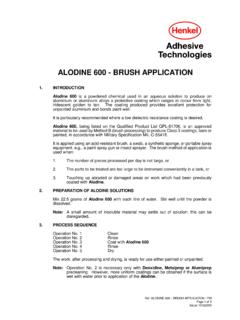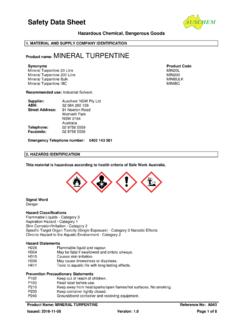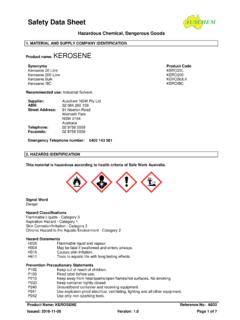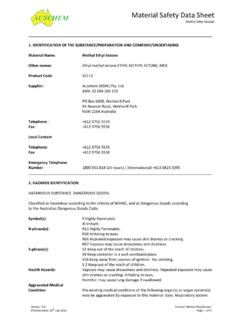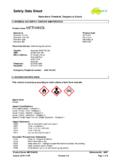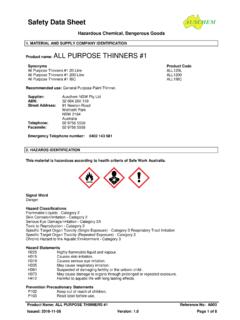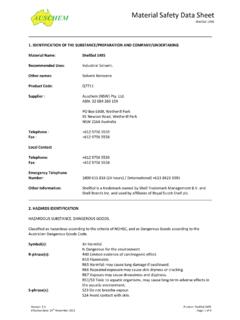Transcription of TECHNICAL INFORMATION ALODINE 1000L - …
1 Ref: ALODINE 1000L /IRR/WG Page 1 of 6 Issue 18th June, 2007 P. O. Box 63 Kilsyth Victoria 3137 Australia 135-141 Canterbury Road Kilsyth Victoria 3137 Australia Tel: (+61) 1300 736 777 Fax: (+61) 3 9761 7179 Henkel Australia Pty Limited ABN 82 001 302 996 TECHNICAL INFORMATION ALODINE 1000L 1. INTRODUCTION ALODINE 1000L is a liquid chemical, used for producing paint-bonding, corrosion-resisting coatings on aluminium and its alloys, by either manual application, spray or dip processing. 2. MAKE UP AND OPERATION ALODINE 1000L is usually made up at 100 litres per 1,000 litres of bath. The same concentration of ALODINE 1000L is normally used for both spray and immersion processes. The bath is operated at 65-70 C and controlled by pH and a titration.
2 3. PROCESS SEQUENCE 1. Preclean. 2. Clean with TURCO 4215S cleaner. 3. Cold water rinse. 4. Coat with ALODINE 1000L . 5. Cold water rinse. 6. Passivation with Deoxylyte* 4. EQUIPMENT The tank and equipment for ALODINE 1000L should be constructed from stainless steel; Type 316 preferred for weldability. If necessary, heated tanks should be fitted with steamplate coils and side heating (for more even temperature distribution). Detailed recommendations on equipment and specific process sequences are available from Henkel TECHNICAL Representatives. ALODINE 1000L Page 2 Ref: ALODINE 1000L /IRR/WG Page 2 of 6 Issue 18th June, 2007 5. BATH MAKE UP AND CONTROL Make Up For each 1,000 Litres of bath volume, add with stirring: Water 900 Litres ALODINE 1000L 100 Litres Control Points (for normal operation) Contact Times Immersion 1-3 minutes Spray 15-30 seconds Spray Pressures N/A 56-84 kPa Bath Pointage 6-7 mL 6-7 mL pH - - Temperature 65-70 C 65-70 C 6.
3 SURFACE PREPARATION The ALODINE 1000L system requires a perfectly clean surface for uniform results. The work is usually cleaned with a TURCO cleaner. Any corrosion products or heavy uneven oxide layers should be removed by immersion in a Henkel Deoxidiser or Aluminium Etchant. Henkel TECHNICAL Representatives will recommend the required cleaning procedure for each installation. The TURCO cleaner stages are usually followed by two 30 second or one 60 second unheated rinse. The rinse is constantly overflowed to prevent buildup of contamination products. 7. TESTING AND BATH MAINTENANCE General The ALODINE 1000L bath is controlled by pH measurement and one titration. The pointage is determined regularly and determines the required amounts of ALODINE 1000L to be added to replenish the bath.
4 Standardisation of Ferrous Ammonium Sulphate (Titrating Solution 31) ALODINE 1000L Page 3 Ref: ALODINE 1000L /IRR/WG Page 3 of 6 Issue 18th June, 2007 TESTING AND BATH MAINTENANCE (continued) i. Pipette exactly mls of Potassium Dichromate Solution (Titrating Solution 30) into a flask. ii. Add 30 ml Reagent Solution 44 (50% Sulphuric Acid). iii. Add 4-8 drops of Ferroin Indicator (Indicator Solution 12). iv. Titrate with Ferrous Ammonium Sulphate (Titrating Solution 31) until the solution changes from green to blood red. v. Record the number of millilitres of Titrating Solution 31 added as A ml. Standardisation factor (F) = A Bath Pointage i.
5 Pipette a 50 ml sample into a 250 ml Iodometric Flask and dilute to about 100 ml with water. ii. Add about 25 ml Reagent Solution 44 and swirl until completely mixed. iii. Add about 5-6 drops Indicator 12 (Ferroin) to the flask and mix. iv. Allow flask and contents to stand for approximately one minute before titrating with Titrating Solution 31 until a blood red colour is obtained. v. Record the number of millilitres of Titrating Solution 31 used as the Bath Pointage. vi. Multiply Bath Pointage value by (F) to get corrected number of mls of Titrating Solution 31 used as the Bath Pointage. To increase bath pointage by 1 ml, add 15 litres of ALODINE 1000L per 1,000 litres of bath volume. Bath pH i. Standardise the pH meter with the correct buffer according to manufacturer's instructions.
6 Ii. Dry electrodes and immerse in sample of ALODINE 1000L bath. iii. Take reading when meter stabilises. The optimum pH is just under iv. Remove electrodes, rinse with distilled water and store in the correct solution. v. The pH will increase as the bath ages. When it reaches , the solution is exhausted and must be discarded. ALODINE 1000L Page 4 Ref: ALODINE 1000L /IRR/WG Page 4 of 6 Issue 18th June, 2007 8. OPERATIONAL RECOMMENDATIONS i. The initial charge and replenishment data contained herein are satisfactory for most installations. However, your Henkel TECHNICAL Representative may suggest a deviation from data if indicated by local conditions. ii. If the ALODINE coating is powdery, the cause may be one or more of the following: - pH too low - Temperature and/or concentration too high for treatment time - Work improperly cleaned or rinsed - ALODINE bath contaminated - analysis required.
7 Iii. If the coatings are uniform but iridescent, the cause may be one or more of the following: - pH too high - Concentration too low - Bath temperature too low for the contact time used - Contact time too short - Reaction products in solution - analysis required iv. If the coatings look patchy, the cause may be one or more of the following: - Cleaner bath exhausted - Incorrect cleaner used - More etching required v. If the coatings look yellow instead of clear, the cause could be either: - Excessive etching leading to smut formation - Desmutter could be required - Contact time is too long 9. AFTER TREATMENT Cold Water Rinse After immersion in the ALODINE 1000L bath, the work should be rinsed for a minimum of 30 seconds in cold water.
8 This tank should have a continuous overflow to avoid build up of contaminants. Deoxylyte Passivation The work is then rinsed for 30 seconds with clean, salt-free water containing Deoxylyte 41 (for maximum corrosion resistance). This stage may be operated hot to facilitate drying and in some cases, may avoid the need for a dry off oven. ALODINE 1000L Page 5 Ref: ALODINE 1000L /IRR/WG Page 5 of 6 Issue 18th June, 2007 Drying The work should be then dried in an indirect fired oven or by other means which will not contaminate the coating with oil fumes or partially burnt gases. The temperature should not exceed 82 C. Solution trapped in cavities should be removed by suction, or with compressed air before drying. 10. PLANT MAINTENANCE Water rinses are ideally dumped each day and made up afresh.
9 Local Water Authorities should be consulted as to the allowable levels of contaminants that can be discharged to sewer. Cleaning stages should be skimmed to keep the surface clean and the bath dumped when excessive soil accumulates in the bath. 11. HANDLING PRECAUTIONS ALODINE 1000L liquid and bath are acidic and poisonous. Fume or spray vapour from an ALODINE bath is toxic. ALODINE baths should be situated in a positively ventilated area. If rags, paper or clothing contaminated with ALODINE dry out, they constitute a fire hazard. Clothing should be promptly washed out and rags and paper should be disposed of in the wet state. Operators handling ALODINE 1000L should wear rubber or heavy plastic gloves, respirators and eye protection.
10 If ALODINE 1000L is splashed onto skin or into eyes; immediately flush with water and seek medical attention. 12. SPECIFICATIONS ALODINE 1000L is a chemical Conversion Coating Material approved under MIL-C-81706 for use by Application Methods A and C, Classes 3, Form 1. Its listing on QPL- 81706-16 indicates its acceptance under MIL-C-5541E. 13. GENERAL Electrical Resistance ALODINE coatings are electrically conductive. The resistance of a coating depends upon its thickness and its age. The lowest resistance is obtained with the lightest coatings and when coatings are fresh ( than 12 hours old), deoxidised surfaces allow a more uniform deposition (and hence lower resistance) to be obtained. A typical figure for the resistance for a fresh coating with a weight around 100mg/M2 (9 mg/sq.)

